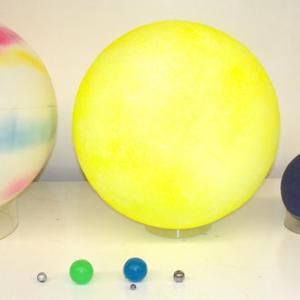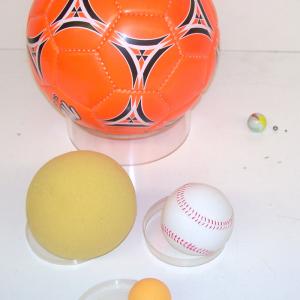College of Liberal Arts & Sciences
8A10.15 - Scale Model Demos of the Solar System
Pick a model that has the appropriate distance scale. Find "planets" of appropriate size and put at the proper distance.
The "in house" model in the first picture shows all the planets to size scale if the Sun is 54 feet 6 inches in diameter. Back row left to right: Jupiter, Saturn, Uranus, and Neptune. Front row left to right: Mercury, Venus, Earth and Moon, Mars, and far to the right between Uranus and Neptune is the minor planet Pluto.
Pictures two and three are of Cornelia Lang's size scale model demonstration. The Sun is represented by the soccer ball which has a diameter of about 8 inches. At that scale the Earth would have a diameter of 0.09 inches, Jupiter would have a diameter of 0.9 inches, and Uranus would have a diameter of 0.3 inches. When presented with the soccer ball "Sun", the students are supposed to pick the correct diameter balls to represent the Earth, Jupiter and Uranus from the supplied samples. The Nerf balls, baseballs, marbles, other ball bearings and balls, and Ping Pong balls are supplied along with the above mentioned diameter samples so that the students have to do some real calculating and thinking to find the right "planets".
- Barbara Rovsek, "Outdoor Science Activity: "Orienteering" Walk Through the Solar System", TPT, Vol. 62, #6, Sept. 2024, p. 451.
- Michael LoPresto, "A Classroom Activity and Laboratory on Astronomical Scale", TPT, Vol. 55, #7, Oct. 2017, p. 442.
- Michael C. LoPresto, Steven R. Murrell, and Brian Kirchner, "Assessment of a Solar System Walk", TPT, Vol. 48, #4, Apr. 2010, p. 236.
- Cliff Swartz, "Pocket Solar System", TPT, Vol. 43, #2, Feb. 2005, p. 120.
- Keneth J. Adney, "Astro-Perspectives", TPT, Vol. 32, #8, Nov. 1994, p. 453.
- Jeffrey O. Bennett, Thomas R. Ayres, Kenneth B. Center, Matthew F. Carer, and Ronald S. Bass, "The Colorado Scale-Model Solar System", TPT, Vol. 29, #6, June 1991, p. 2371.
- Jay M. Pasachoff, "Teaching About the Planets at (Large) Scale", TPT, Vol. 27, #1, Jan. 1989, p. 38.
- Joe L. Ferguson and F. Glenn Liming, "Model of the Solar System", TPT, Vol. 16, #4, Apr. 1978, p. 223.
- Lars Broman, "A Model of the Solar System Improved by Means of Pinhole Optics", TPT, Vol. 11, #8, Nov. 1973, p. 489.
- David Kutliroff, "How Empty is Space in the Macrocosm?", 101 Classroom Demonstrations and Experiments for Teaching Physics, p .122.
- Janice VanCleave, "Make a Scale Model of the Planets of the Solar System That Shows the Planets' Distances from the Sun", Super Science Challenges, p. 9.
Disclaimer: These demonstrations are provided only for illustrative use by persons affiliated with The University of Iowa and only under the direction of a trained instructor or physicist. The University of Iowa is not responsible for demonstrations performed by those using their own equipment or who choose to use this reference material for their own purpose. The demonstrations included here are within the public domain and can be found in materials contained in libraries, bookstores, and through electronic sources. Performing all or any portion of any of these demonstrations, with or without revisions not depicted here entails inherent risks. These risks include, without limitation, bodily injury (and possibly death), including risks to health that may be temporary or permanent and that may exacerbate a pre-existing medical condition; and property loss or damage. Anyone performing any part of these demonstrations, even with revisions, knowingly and voluntarily assumes all risks associated with them.


